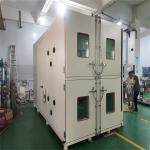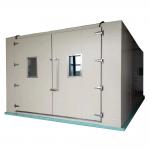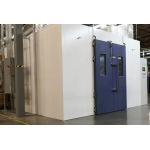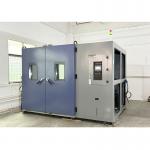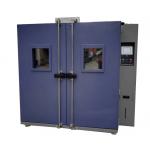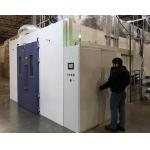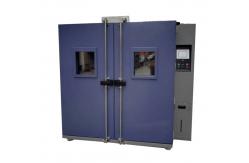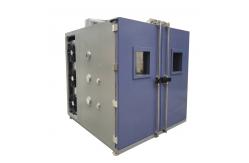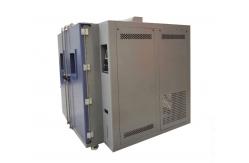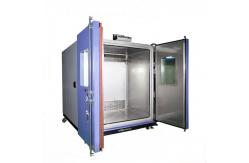In the highly demanding and technologically advanced aerospace
industry, the performance and reliability of components under
diverse environmental conditions are of utmost significance. The
Customized Temperature Humidity Control Walk-In Environmental
Chamber emerges as a crucial tool, meticulously designed to meet
the specific and stringent requirements of testing aerospace parts
and systems. This state-of-the-art environmental chamber is dedicated to
subjecting aerospace components, such as avionics, engines,
structural elements, and materials, to a precisely controlled
combination of temperature and humidity conditions. It serves
aerospace manufacturers, research institutions, and regulatory
bodies. The primary objective is to evaluate the behavior,
durability, and functionality of these components in a wide range
of environmental scenarios that they might encounter during their
operational lifespan, from the extreme cold of high-altitude
flights to the humid and hot conditions in tropical regions or
during ground maintenance. By replicating these conditions in a
laboratory setting, manufacturers can identify potential
weaknesses, optimize product designs, and ensure compliance with
the exacting industry standards and safety regulations. - Robust and Insulated Chamber Structure
- The walk-in chamber is constructed with a heavy-duty,
aerospace-grade alloy frame and insulated walls. The alloy frame
provides exceptional strength and rigidity, ensuring the chamber
can withstand the rigors of continuous and long-term testing. The
insulation materials are carefully selected to minimize heat
transfer and maintain highly accurate temperature and humidity
gradients within the chamber. The chamber is sealed with advanced,
high-temperature and corrosion-resistant gaskets and precision
sealing mechanisms to prevent any air leakage, which could
compromise the integrity of the test environment. The door is
equipped with a reliable locking system and a large,
pressure-resistant viewing window, allowing operators to closely
monitor the test process without disturbing the internal
conditions. The interior of the chamber is designed with smooth,
easy-to-clean surfaces to prevent any particulate or contaminant
buildup that could affect the test results.
- Precision Temperature and Humidity Control System
- The heart of the chamber lies in its advanced temperature and
humidity control system. It can achieve a wide temperature range,
typically from -70°C to +120°C, with an accuracy of ±0.3°C. The
humidity control range extends from 5% to 95% relative humidity,
with an accuracy of ±2% RH. The system utilizes high-performance
refrigeration units, electric heaters, humidifiers, and
dehumidifiers, all coordinated by a sophisticated PID controller.
Temperature and humidity sensors are strategically placed
throughout the chamber, providing real-time feedback, enabling the
control system to make instantaneous and highly accurate
adjustments. The system is also designed to handle rapid
temperature and humidity transitions, mimicking the sudden changes
that aerospace components may experience during flight or ground
operations.
- Advanced Airflow and Circulation Design
- To ensure uniform temperature and humidity distribution within the
large volume of the walk-in chamber, an advanced airflow and
circulation design is incorporated. The system consists of multiple
high-capacity fans and a network of ducts and baffles. The fans can
generate adjustable air velocities, typically ranging from 1 m/s to
5 m/s. The airflow is carefully directed to eliminate any stagnant
areas or temperature/humidity gradients, ensuring that all parts of
the test samples are exposed to the exact same environmental
conditions. This is crucial for obtaining accurate and reliable
test results, especially when testing large and complex aerospace
assemblies.
- Intuitive Control Panel and Data Acquisition Interface
- The equipment is equipped with an intuitive control panel that
simplifies the operation and parameter setting. Operators can
easily adjust the temperature, humidity, test duration, and other
parameters using the user-friendly interface. The control panel
also provides real-time displays of the current test conditions, as
well as any alarms or warnings. The chamber is integrated with a
comprehensive data acquisition system. It records all relevant test
data, such as temperature and humidity histories, rate of change of
environmental parameters, and any observable changes in the test
samples. The data can be stored in a built-in memory or exported to
external storage devices for further analysis. The system can also
generate detailed test reports in various formats, facilitating
easy documentation and sharing of results.
- Versatile Sample Fixturing and Placement
- The interior of the chamber is designed to accommodate a wide
variety of aerospace sample sizes and shapes. It can be equipped
with adjustable racks, trays, and custom-made holders to ensure
proper positioning and exposure of the test samples. The sample
fixturing is made of materials that are non-reactive with the test
environment and do not contaminate the chamber. This flexibility
allows for the testing of different products, from small avionics
components and connectors to large aircraft wings or engine
nacelles. For example, an aircraft wing section can be mounted on a
specialized fixture to evaluate the integrity of its composite
materials and joints under different temperature and humidity
stresses, while a set of avionics circuit boards can be placed on a
rack to test their performance and reliability in a humid and
temperature-variable environment.
- Maximum Temperature Swing and Accuracy
- With a temperature range spanning from -70°C to +120°C, the chamber
can achieve a maximum temperature swing of 190°C. The accuracy of
±0.3°C ensures that the test conditions are precisely maintained,
providing reliable and repeatable results. This wide temperature
spectrum is essential for testing aerospace components that may be
exposed to the frigid temperatures of the upper atmosphere or the
heat generated during engine operation or re-entry. For example, a
satellite component may need to be tested at extremely low
temperatures to ensure its proper functioning in space, while a jet
engine part may require high-temperature testing to evaluate its
thermal stability.
- Humidity Range and Rate of Change Accuracy
- The humidity range of 5% to 95% RH, with a rate of change accuracy
of ±2% RH, allows for a comprehensive evaluation of the effect of
moisture on aerospace products. The ability to precisely control
the humidity level and its rate of change helps in understanding
how components respond to different moisture environments, such as
the condensation that may occur during rapid altitude changes or
the humid conditions in tropical airports. This is crucial for
ensuring the integrity of electrical systems, preventing corrosion
of metal parts, and maintaining the performance of composite
materials.
- Testing Volume and Payload Capacity
- The chamber offers a customizable testing volume, with options
ranging from 10 m³ to 100 m³. The payload capacity can be adjusted
according to the size and weight of the test samples, with a
maximum capacity of up to 5000 kg. This allows for the testing of a
significant number of samples or larger and heavier aerospace
assemblies. For example, a complete aircraft fuselage section or a
large rocket engine can be accommodated in a suitably sized
chamber, enabling comprehensive testing of these critical
components.
- Data Sampling Frequency and Resolution
|
